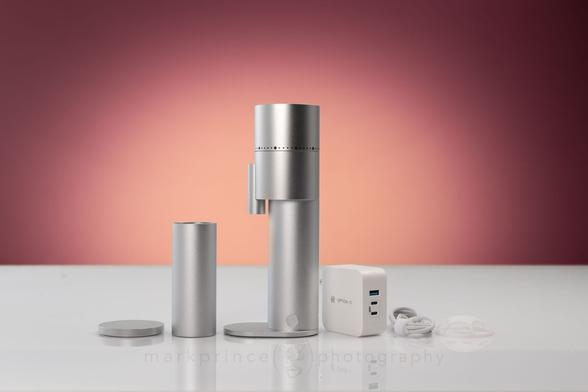RE: https://bsky.app/profile/did:plc:nljb72czrjtj4po3m5rz2iev/post/3m3md5agbi22r
Cafeteros de espresso de mi timeline, que molinillo tenéis?
I’m not surprised at all to learn that the crying Nazi is on grinder seeking out men to have sex with.
I guess I’m also not surprised to hear that he has the gang stalking delusion.
But I am concerned that he believes that these men are spreading disease to him on purpose as part of the gang stalking.
PLEASE MAKE SURE YOU DO A BIT OF RESEARCH BEFORE MEETING A STRANGER FOR A DATE.
#LGBTQ #NH #CryingNazi #grinder #GangStalking #delusions #FreeStaters

The Crying Nazi Turned Gay Erotica Author: Christopher Cantwell
Meet the Lagom mini 2: Option-O’s Compact Electric Grinder Evolves
There’s a strange chasm in the world of coffee grinders. On one side, you have the hefty, countertop-hogging electric grinders, beasts of burden that can churn out shot after shot. On the other, you have the admittedly excellent but arm-tiring manual grinders, the darlings of the purist set. For years, if you wanted electric convenience in a travel-friendly size, your options were, let’s just say, rather disappointing.
Option-O, after just six years in the grinder game, saw that gap and drove a truck through it with the original Lagom mini in 2022. Now they’re back with its successor, the Lagom mini 2. Externally, it’s a dead ringer for the original, save for a redesigned power button and a modern USB-C port replacing the old one. But while the shell is identical, what’s under the hood is a thoughtful evolution, not a revolution.
Before I dive in, a quick disclosure. My evaluation grinder wasn’t purchased; it was provided by Option-O (not a sponsor) through their Canadian retail partner, Cafuné (welcome to them as a new site sponsor!). I’m grateful to both for getting one to me, especially since high demand has created waiting lists for these unique grinders. This article is my detailed introduction to the mini 2 our full Snapshot Review is coming in the next few months.
The Original Lagom mini: A Quick Look Back
The first Lagom mini was a masterclass in purpose-built design (here’s my original intro article on it). While its size made it an excellent travel companion, its true calling was to be the ultimate minimalist grinder for the discerning coffee lover at home. It was engineered to look beautiful while taking up almost no space, its low 180 RPM motor prioritizing quality and excellent fines management over sheer quantity.
The original Lagom Mini, with the 48mm Moonshine burrs inside.It had its quirks, of course. The proprietary power brick was an awkward, outlet-hogging annoyance on the kitchen counter and a pain for travellers alike. And while the grinder’s design screamed minimalist chic, its un-numbered dial was a famously polarising choice.
The original mini’s power brick, a dedicated wall adapter that took up a lot of plug space.Still, the results were undeniable. I have nearly two years of experience with the original mini, and its grind quality is nothing short of phenomenal. In fact, it’s become a benchmark for conical burr grinders here at CoffeeGeek, because of its incredible output, build quality, and unique place in the market. My expectations for this new version, with its refined burrs, are deservedly high.
Familiar Form, Subtle Changes
If you liked the original mini’s look and feel, you’ll be happy to know the exterior is fundamentally unchanged. The mini 2 has the same compact footprint, satisfying 1.5 kg (3.3 lbs) heft, and premium, machined-from-a-single-block-of-aluminum feel. The fit and finish are superb, making many larger plastic grinders feel clumsy by comparison, and the magnetic catch cup still snaps into place with an authoritative click.
While the body is identical, I found a few subtle changes. Aesthetically, the tasteful, minimalist branding etched onto the original mini’s base is gone, leaving the new version completely unadorned. On a more practical note, the base now has a compliance sticker that can make the grinder slide around. My advice? Peel it off at your earliest convenience, and the grippy silicone base will keep the grinder planted.
Original mini on the right with subtle branding laser etched onto the grinder; the mini 2 on the left has no branding.The adjustment mechanism is almost identical to the original, save for the omission of a single hollowed-out marker dot near the zero point. The entire upper collar remains a stepless grind adjustment, threading smoothly into the main body. If you’ve ever dialled in an espresso shot with this style of infinite adjustment, you know how precise it can be.
Here’s the grind dials on both the mini 2 (left) and mini (right; note the original mini has a hollowed out “zero” dial (it wasn’t really a zero point), and a deeper, bigger indent to mark the grind setting.Internally, Option-O has again strengthened the gearing system and motor housing to improve torque. The same P-grade angular contact bearings are used to ensure the burrs remain perfectly aligned with minimal wobble. The workflow is still strictly single-dosing only, with a hopper capacity of around 30 to 35 grams for those who meticulously weigh their beans. It also still comes with the removable anti-popcorn device, which, let’s be honest, most of us remove because it can make pouring beans in a bit harder.
The Burrs: An In-House Evolution
This is the upgrade that will likely interest CoffeeGeek readers the most. The original Lagom mini’s burr options evolved over its lifespan: it launched with 38mm Obsidian burrs as standard, with an optional upgrade to a 48mm Moonshine burr set. The Moonshines developed such a strong reputation for clarity that Option-O eventually made them the standard offering. The new mini 2 continues this evolution, simplifying the lineup to a single, new 48mm Mizen burr set.
The original mini (left) and the new mini 2 (right); note the vanes in the grind chamber, and the outer burr assemblies.Option-O has taken a more hands-on role with the Mizen burrs. While they use third parties for manufacturing, the design is now done entirely in-house, with each burr set undergoing individual quality control before shipping. This gives them complete command over geometry and consistency. The Mizen 48MS burrs have a cut pattern that is nearly identical to the Moonshines, but the finish appears more matte. The high sheen on my well-used Moonshine burrs might just be the result of two years of polishing, but it’s a noticeable difference out of the box.
Beyond the burrs themselves, there’s a significant change to the grind chamber. The original mini had stepped clearing vanes and a lipped outer burr housing, which could trap a small amount of coffee grounds over time. The mini 2 now features single-height vanes and a flat burr housing, creating a wider sweep area. In my initial testing, this new design seems to do a much better job of clearing out ground coffee.
The moonshine burr on the left has a higher sheen and note the lip in the burr bottom; the Mizen on the right is flat across its bottom, and the burrs are more matte in finish.As for performance, Option-O describes the Mizen burrs as all-rounders, and my testing confirms this. They produce brews with medium-high clarity and good flavour separation, performing well from fine to coarse.
One critical note for owners of the original: these new Mizen burrs are not backwards compatible. You cannot install them in a first-generation Lagom mini.
Power: USB-C Changes Everything
Let’s have a moment of silence for the junk drawer full of proprietary power bricks we have all accumulated over the years from a wide variety of retired and deceased consumer appliances. The single biggest and most welcome change in the mini 2 is the switch to the universal USB-C standard.
This is not just any USB-C port, however. It requires a power source that supports Power Delivery 3.0 (PD3.0 or later) and can output a full 100 watts at 20V/5A. In simple terms, it needs a powerful, modern charger, like one you would use for a MacBook Pro.
Option-O sells the grinder direct, in two configurations:
- $299 USD / $415 CAD without a power adapter (you supply your own, like the Ugreen Nexode Pro 100W)
- $379 USD / $527 CAD with Option-O’s high end 100W USB-C power adapter.
That power adapter deserves special mention. It is not just a simple brick; it is a proper PD3.0 compliant multi-port GaN charger with two USB-C ports, one USB-A port, and a high-quality braided cable. In Canada, Cafuné offers the grinder for $499 CAD without the adapter and $599 CAD with it, which is a competitive price once you account for duty and shipping.
The 100W, PD3.0 compliant 20V/5A adapter for the Lagom mini 2: extra USB ports for your other devices!The move to USB-C also unlocks the grinder’s true potential for portability. It can be run from a 100W+ PD-compliant power bank. This flexibility elevates the mini 2 from just a small grinder to a genuinely portable one. I’m testing it with an INIU Cougar 100W 25,000mAh power bank, and it works fantastically well as a standalone grinding solution.
If you get yourself a PD3.0, 100W (minimum via one port) USB-C power bank, like this Iniu version, you can power the grinder all day long “off the grid”.Workflow: Smarter, Not Harder
The other major quality-of-life improvement is the introduction of an auto-off feature. The grinder’s internal logic now detects when the resistance drops, meaning the beans have all passed through the burrs. It continues to run for about ten seconds to clear the chamber and then shuts itself down.
If you have ever been sidetracked by a ringing phone or a boiling kettle, you might have returned to the sound of the original mini’s motor spinning away uselessly, slowly eating into its 600-hour rated lifespan. The auto-off function means less wear, less heat, and less stress on the motor. It also frees you up to prep your filter or tamp your espresso while the grinder finishes its job.
During that final ten-second spin-down, the mini 2 makes a soft “pffft, pffft” sound as it pulses to push out the last few particles. Retention seems improved, and static is noticeably lower than in the original. These are just my initial impressions, of course; we’ll be doing more rigorous testing on retention and static for the full Snapshot Review.
The Grind Dial: Precision with Visual Cues
And now we come to the dial. While it has no numbers, it does have dots! (this is a point of contention with some owners of the grinder who want numbers on the dial). The collar features a series of large dots interspersed with four smaller dots, giving you a solid visual reference for your grind setting. Option-O’s philosophy is to encourage dialing in by taste and feel, using these markers as waypoints, and they have steadfastly resisted calls to add numbers to the stepless adjustment. For those who want to mark specific settings, they include a sheet of tiny black and white dot stickers for further customization.
I’ve developed my own system with the stickers to keep things straight. I use a single white sticker placed directly on one of the laser etched black dots, to mark the effective zero point. My starting point for espresso is marked with a single black sticker above the seventh large dot. For pour over, which requires a full 360-degree rotation past zero, I use two white stickers over the fourteenth large dot. The two stickers are a quick visual reminder that I have to pass that point one full rotation first before reaching it again.
The grind dial on the mini 2; I use dots to indicate grind position and how many rotations to do. The black dot is espresso, the two white dots are V60 grind setting baseline.Honestly, I’m still on the fence about the whole numbers-versus-no-numbers debate. It’s a system that works well once you get used to it, but I understand the appeal of a simpler numerical reference. I’ll have a more definitive take in our full Snapshot Review.
Reliability and Final Thoughts
The Lagom mini 2 inherits the gearbox and motor improvements made in later production runs of the original, and even adds more beefing up and refinements to the system. The auto-off feature adds another layer of protection. The same duty cycle of 1:1 (eg 60 seconds on, 60 seconds off) applies, so this is not a machine for grinding large batches. But for its intended use of delivering a few exceptional doses per day, it should prove to be a reliable companion.
So, who is this grinder for? It’s for the person who values minimalism, counter space, and exceptional grind quality in small amounts. It is for the filter-first coffee drinker who enjoys the occasional espresso. It competes with top-tier manual grinders, and the debate boils down to this: do you prefer the tactile ritual of hand grinding, or would you rather just press a button? After years of daily hand grinding, the appeal of that button gets awfully strong.
And here’s the kicker, the part that seals the deal. In a world where every new version of a gadget seems to come with an automatic price hike, Option-O went the other way. If you bring your own compliant USB-C charger, the mini 2 is actually about a hundred bucks cheaper than its predecessor (excluding any possible Trump Taxes). Even if you opt for the bundle with their excellent new power adapter, it still rings in at about twenty dollars less than the old model with the dedicated power brick.
In my limited testing, the grinder did not exceed 55W power draw, even under load. But it was pulling a full 20V, which is the more crucial part and why having the right power brick (or power bank) is crucial for this grinder to work. I will test this further for the full review.The Lagom mini 2 is both an incremental and unique-features upgrade. It takes a product we already loved and refines it based on lots of user feedback. The Mizen burrs, improved motor, universal USB-C power, and the smart auto-off function are all excellent improvements that make a great grinder even better.
So, that’s my initial take. We’re now working on the full Snapshot Review for the grinder which should be along in a few months. If you’ve managed to get your hands on a Lagom mini 2, drop a comment below and let us know what you think. If you’ve got questions, fire away. Don’t be shy.
#coffeeGrinder #grinder #lagom #lagomMini2 #optionO #singleDose
Novembeat 2021: Lo-Fi Beats to Grind Coffee To

Novembeat 2021: Lo-Fi Beats to Grind Coffee To
Grinder mod didn't go well - after cleaning it then replacing the outer burr, I decided to check if this initial change worked. Switched it on, nothing happened (heart sank a bit). I then noticed a small PCB that didn't look right - the connector to the motor moved a bit too much. I initially thought cracked solder joints (easy fix: reflow solder) but it was lifted pads. Soldered two short thick wires to nearby vias and it worked.
Mod postponed to another day.

